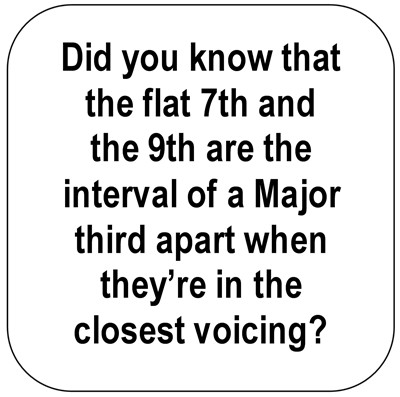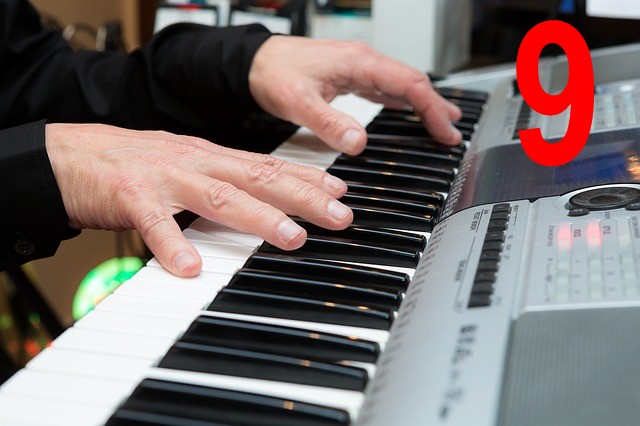This article is about how to play 9th chords on the piano | how to understand and play them. In an earlier post, I showed you how easy it is to play dominant 7th chords on the piano. Included in that, is a couple of simple ways to find the dominant 7th of any triad.
Learning how to easily play 9th chords on the piano doesn’t have to be complicated.
But first, let me answer the question that you may be asking: What exactly are 9th chords?
A 9th chord is more specifically called a dominant 9th chord. This is directly related to a dominant 7th chord. In fact, a dominant 9th chord is nothing more than a dominant 7th chord with an extra tone added that is referred to as the 9th.
I know this may sound like a mouthful so let me break it down to make it easier for you to learn to play 9th chords on the piano.
If you remember from the earlier post: “How to Easily Play Dominant 7th chords on the Piano“, you’ll recall that a dominant 7th chord is formed by adding a flatted 7th to a triad. (review the article if you would like to)
Here’s the C dominant 7th chord.

But, I also said that they’re most often referred to as 7th chords. Most musicians don’t really emphasize the word “dominant” explicitly. They just keep it short and sweet. However, if you’re not in the loop, it can be confusing.
Students will often ask me: If there are only 7 notes in music, how can you come up with a 9th?
There are tones that are referred to as higher extensions. They’re also diatonic which means they are found within the key the chord is based on.
So if you continue to count up past the octave (which is 8), you’ll move to the 9th tone in the key. This 9th is where the dominant 9th chord gets its name.
Here’s the 9th tone in the key of C Major

The dominant 9th chord extends the chord further by adding this 9th degree to an already formed dominant 7th chord.
Here’s a Keyshot of the C dominant 9th chord. Remember, you’re adding the 9th tone to an already formed dominant 7th chord.

If you haven’t already noticed, the 9th and 2nd are the exact same note. So why would you refer to the 2nd tone as a 9th? After all, there are chords in which you’ll add the 2nd note to and you’ll actually call them an add 2 chord.
But this isn’t one of them. Here’s a very simple rule to reference when you see a 9th chord in music. The dominant 7th is implied. This means that you play the dominant 7th in the chord along with the 9th tone without being told to do so.
Musicians usually don’t make any reference to the dominant 7th being in a 9th chord. So it’s  important to remember that the dominant 7th is always implied.
important to remember that the dominant 7th is always implied.
Just remember this: If the dominant 7th is not being played, it’s not a 9th chord. (or a dominant 9th chord if you want to refer to it formally) It’s another type of chord that we won’t cover here. But the dominant 7th makes a very big difference.
Even though by definition, the 9th tone in the key is defined by counting up from the root (1st note) all way up to the 9th, you can easily remember that the 9th in any key is whole step up from the root. You’ll also know this as the 2nd.
Just remember that it’s not called a 2nd because the dominant 7th is present. I know I keep reiterating this but it’s a critical thing to remember so you won’t be confused about the same note being referred to by two different numbers.
Let’s create some dominant 9th chords in other keys besides C Major.
Here, we have a simple D Major Triad. Can you create a dominant 9th chord from this simple triad?

First we have to add the dominant 7th that this 9th chord implies.
In an earlier article I showed you that all you had to do to find the dominant 7th of any chord is to find the note that is a whole step below the root.
In this case the note that is a whole step below the root is C.

So C is the dominant 7th of D Major.
To put this in context, let’s play the C an octave higher.

Now we have an easily defined D dominant 7th chord.
Can you remember how to find the 9th?
Remember the simplest way to find the 9th is to locate the note that’s a whole step up from the root.

So the 9th tone in D Major is E.
Move the 9th up an octave as you did before for a well defined D dominant 9th chord.

Let’s take D flat Major as an example.
Here’s the D flat Major Chord

Now find the dominant 7th. This time skip the linear method in which you would count up and just find the note that is a whole step below the root.
If you chose B (aka C flat) then you’re right.

Move the flat 7th up an octave as you did before.

Now what’s the 9th of the D flat Major?
Absolutely! It’s E flat. (I of course moved the 9th up an octave as I did before)

I want to let you find this next dominant 9th chord.
Let’s try A dominant 9. (Also simply known as A9)
Do you know the dominant 7th of A Major?
Remember, you can find the dominant 7th by locating the note that is a whole step below the root.

If you came up with G, that’s absolutely correct.
So here’s what your A7 chord would look like in root position.

Now find the 9th of A Major.
Do you remember where to look?

That’s right. A whole step above the root is the 9th.
Move the 9th up an octave and you have a clearly defined dominant 9th chord.

It’s that simple to create 9th chords on the piano!
Closing Thought
Along with 7ths, 9ths are “Color Tones” that are played within chords. The purpose of color tones is to (you guess it) add color to your chords. What does it do? It makes your chords shine and sound professional by adding another layer to them.
There’s a lot of piano players out there that play basic vanilla chords such as triads and other basic elements of harmony that sound so uninspiring and dull. When you understand the concept of adding color tones to your chords, your music comes alive and you sound like a professional at your piano. Read this article again and follow along on your piano to get these 9th chords into your hands.
If you understand the concept of how to create 9th chords in every key, you’ll have another tool to make your piano playing sound professional. Until next time, Go Play!





